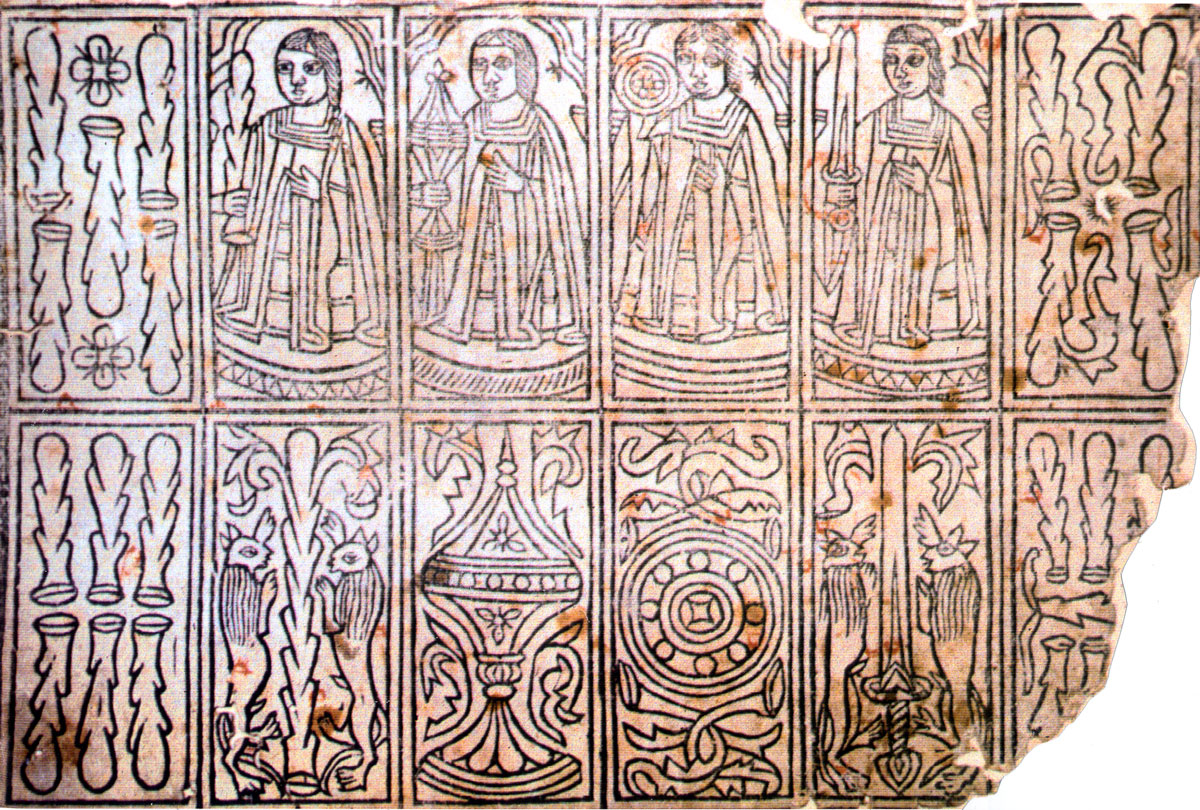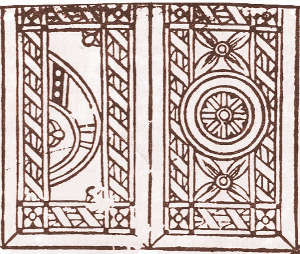XV Century Catalan playing cards
XV Century Catalan Playing Cards, featuring four female Sotas, four Aces and four cards from the suit of batons.
These ancient playing cards were discovered inside the binding material of a printed Catalan book dated 1495. As there are no other surviving examples, it is likely that it is a sole remnant of an archaic Spanish-suited pattern, perhaps used in a particular area, which has been superseded. The four female Sotas (not Queens) stand inside niches and on circular bases; they are quite similar to those in later Portuguese packs. But are they female, or in fact young male figures? They wear long robes reaching the floor and each holds their respective suit symbol in their right hand.
It seems likely that the complete pack contained 48 cards = 4 sheets of 12 cards. We do not know whether the kings were seated or standing, or whether there were cavaliers or knights on the missing cards. The batons are knobbly and arranged in a similar way to what we know today as ‘Spanish’: we might expect the cups, coins and swords to be similarly arranged. The four aces are decorated with primitive acanthus leaves or foliage, and two of them are also supported by lions.

Above: uncoloured and uncut sheet of 12 XV Century Catalan Playing Cards, Barcelona, printed in black onto thin paper and then glued onto a manuscript (latin) page, discovered during restoration inside the binding material of a Catalan book titled El Llibre de les Dones, printed by Johann Rosembach and dated 1495. Four (female) Sotas stand inside niches and on circular bases. They wear long robes and each holds their respective suit symbol in the right hand. Note that they are not 'Queens' and have no crowns. The cards were housed in the Instituto Municipal de Historia (Barcelona) when the photograph was taken (1986), and also illustrated in Trevor Denning's The Playing-Cards of Spain, Cygnus Arts, London, 1996.
NOTE: the original cards are now preserved in the Arxiu Històric de la Ciutat de Barcelona • 26453-Antiquària • zoom ►
If the Latin suit system, including the Spanish variant illustrated here, derived from Islamic cards, then we have an early example of cards faithful in some ways to their Islamic origin, produced at a time when possibly both styles were still in use, and before other versions of Spanish-suited cards were adopted. See also: Moorish Playing Cards • Mamluk Cards • Master of the Banderoles • Gothic Spanish Cards.
The materials used in card games are very perishable so surviving early specimens are very rare. More than one example has come to light inside book bindings when these needed to be repaired, as in this case. Because games are a magnificent way of promoting social relationships, as well as “unleashing passions”, these late fifteenth century playing cards give us a sense of how the Catalan capital absorbed foreign cultural elements and in turn spread their own style abroad.

By Simon Wintle
Member since February 01, 1996
I am the founder of The World of Playing Cards (est. 1996), a website dedicated to the history, artistry and cultural significance of playing cards and tarot. Over the years I have researched various areas of the subject, acquired and traded collections and contributed as a committee member of the IPCS and graphics editor of The Playing-Card journal. Having lived in Chile, England, Wales, and now Spain, these experiences have shaped my work and passion for playing cards. Amongst my achievements is producing a limited-edition replica of a 17th-century English pack using woodblocks and stencils—a labour of love. Today, the World of Playing Cards is a global collaborative project, with my son Adam serving as the technical driving force behind its development. His innovative efforts have helped shape the site into the thriving hub it is today. You are warmly invited to become a contributor and share your enthusiasm.
Related Articles

Pierre Varangot
Tracing the origins, legality and legacy of Pierre Varangot’s San Sebastián deck.

Archaic Spanish-suited pattern from Bayonne
Archaic Franco-Spanish pattern from Bayonne by a manufacturer with the initals M.V.

French Revolutionary cards by Pinaut
Seven cards from a French Revolutionary pack by Pinaut featuring characters from classical antiquity...

Tarot de las Coscojas
Historical playing card design, tarot symbolism and an almost psychedelic medieval surrealism.

Tarot de Valverde de la Vera
A series of 24 surrealist engravings by Mexican artist Claudio Favier in which archetypal Tarot alle...

Baraja de Juan Martín Zamorano
Deck inspired by El Pendón de los Zamorano, a military pennant dating from 1501, published by Priego...

Heráldica Castanyer No. 16
Strange variant of international pattern cards for poker or bridge.

Fantasy Spanish-suited deck
Fantasy Spanish-suited deck by Bertschinger y Codina, Barcelona.

Trappola cards from Poland
Trappola cards published in Warsaw by J G Du Port during the 18th century.

Bertschinger y Codina - Cartes Françaises
French ‘Paris’ pattern made by Bertschinger y Codina, Barcelona, c.1850.

Braulio Fournier
Baraja Nº 1 produced by Braulio Fournier, Burgos, c.1868.

Pirritx eta Porrotx
Happy Families card game from the Spanish Basque Country.

Naipe Vizcaino
‘Naipe Vizcaino’ designed by Javier Urkiri and published by Industrias Gráficas Castuera and the Caj...

Baraja Turística del País Vasco
Basque poker deck of 55 cards published by Fournier with scenic views of the Basque Country.

Baraja Vasca
Spanish Basque Country deck with original drawings by María Isabel Ibañez de Sendadiano.

Baraja Cultura Española
ASESCOIN pack for 2022 designed by M.A. Corella featuring famous Spaniards and notable buildings.
Most Popular
Our top articles from the past 28 days


